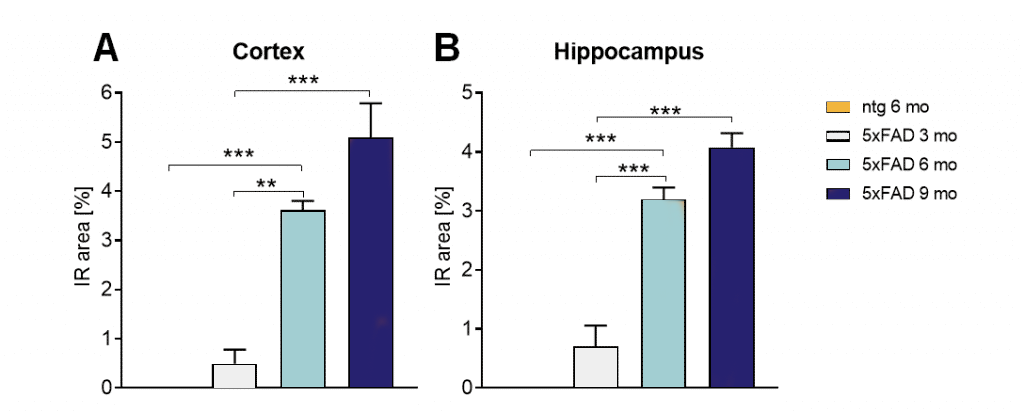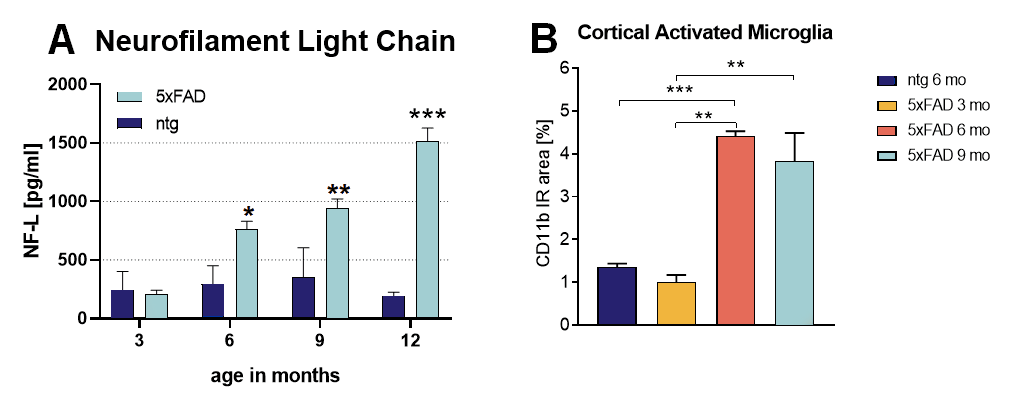5xFAD (Familiar Alzheimer Disease) mice bear five AD-linked mutations, three in the APP695 gene [APP K670N/M671L (Swedish), I716V (Florida), V717I (London)], and two more mutations in the PSEN1 gene [M146L, L286V]. The expression of the 5xFAD transgene is driven by the neuron-specific Thy1 promoter.
The 5xFAD transgenic mouse model highly overexpresses Aβ1-40 and Aβ1-42 in the brain and cerebrospinal fluid which rapidly increases during aging. Histological analyses of the cortex and hippocampus revealed a dramatic plaque load and β-sheet formation accompanied by strong neuroinflammation. These pathological hallmarks also significantly increase with age. Female 5xFAD mice express slightly more APP than male 5xFAD mice. This difference might be caused by an estrogen response element in the Thy1 promoter. Animals present spatial and long-term memory deficits as analyzed by the Morris water maze. Motor deficits were not detected.
5xFAD mice are thus a suitable model to study the influence of drugs on amyloid production, sequestration and deposition, the involvement of presenilin1 and inflammation.
The most important characteristics of 5xFAD mice are:
- Increased Aβ in cortex and hippocampus
- Strong amyloid plaque accumulations
- Increased neurofilament light chain levels (NF-L)
- Increased neuroinflammation levels
- Spatial and long-term memory deficits

Figure 1: Aβ42 level in the cortex (A) and hippocampus (B) of 3-, 6- and 9-months old 5xFAD mice. Immunoreactive (IR) area in percent; n = 3. Mean + SEM. One-way ANOVA with Bonferroni’s post hoc test. **p<0.01; ***p<0.001.

Figure 2 A: Quantification of neurofilament light chain in the plasma of 5xFAD mice. NF-L levels in pg/ml in the plasma of 3-, 6-, 9- and 12-months old 5xFAD mice compared to non-transgenic littermates. Mean + SEM; n = 4-8. Two-way ANOVA with Bonferroni ‘s post hoc test. B: Activated microglia in the cortex of 3-, 6- and 9-months old 5xFAD mice. Immunoreactive area in percent in the cortex; n = 3. Mean + SEM. One Way ANOVA with Bonferroni’s post hoc test. *p<0.05; **p<0.01; ***p<0.001.
Scantoxy offers a custom-tailored study design for 5xFAD mice, and we are flexible to accommodate your special interests. We are also happy to advise you and propose study designs. 5xFAD mice show relevant features of AD already at 6 months of age. Based on various options to study 5xFAD mice, your study will be customized according to your requirements. Furthermore, non-transgenic littermates are available as control animals needed for proper study design.
We are happy to evaluate the efficacy of your compound in the 5xFAD mouse model! The most common readouts are:
- Aβ levels and Aβ aggregates
- Neurofilament light chain (NF-L) levels
- Cytokine and neuroinflammation levels
- Aβ plaque load
- Tau phosphorylation levels
- Learning deficits and memory loss
